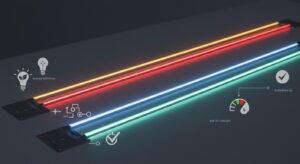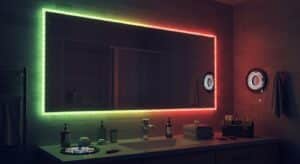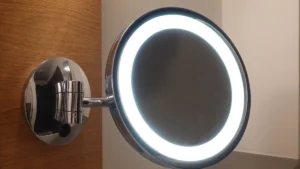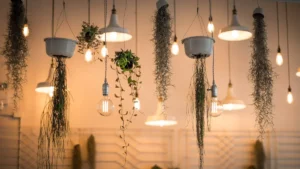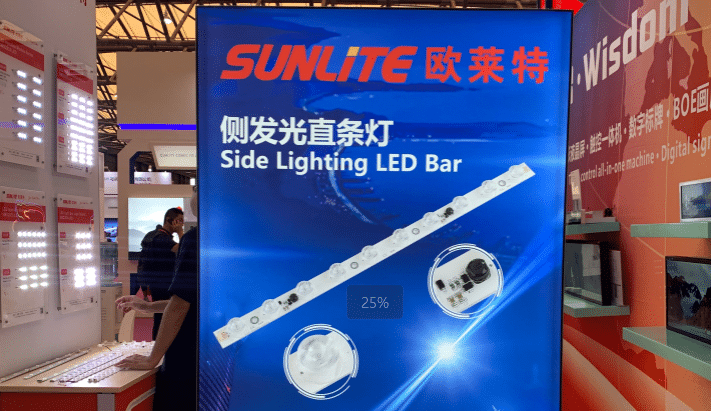
You rely on LED light bars to achieve bright, uniform illumination in lightboxes. These bars distribute light evenly, ensuring no shadows or hotspots disrupt the display. Compared to traditional lighting, an LED light bar emits more light per watt, making it highly energy-efficient. Its durability allows it to withstand harsh conditions, making it ideal for both indoor and outdoor signage. When installed correctly, it enhances the visual appeal of your lightbox by providing consistent brightness across the surface, ensuring your message stands out.
Key Takeaways
LED light bars give bright and even light, making signs look better.
They save energy, lower electricity bills, and help the environment.
Installing and placing them correctly removes shadows and keeps brightness steady.
There are different kinds, like edge-lit and backlit, for different needs.
Cleaning and checking them often makes them last longer and work well.
Understanding LED light bars
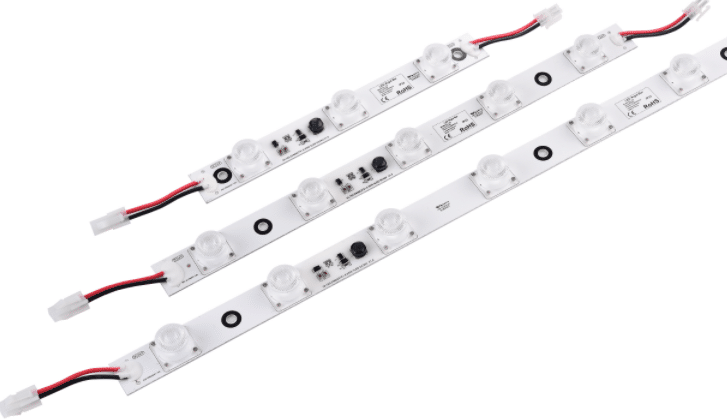
What are LED light bars?
LED light bars are linear lighting devices that use light-emitting diode technology to produce bright, energy-efficient illumination. These bars are designed to provide consistent lighting across surfaces, making them ideal for applications like lightboxes. Unlike traditional lighting, an LED light bar consumes less power while delivering higher brightness. Its compact design allows it to fit seamlessly into various lightbox configurations, ensuring your signage looks professional and visually appealing.
Key components of an LED light bar
To understand how an LED light bar works, you need to know its essential components. Each part plays a critical role in ensuring optimal performance and durability.
LED chips
The LED chips are the heart of the light bar. These tiny semiconductors emit light when an electric current passes through them. They are highly efficient, converting most of the energy into light rather than heat. This efficiency ensures your lightbox remains bright without excessive energy consumption.
Aluminum housing
The aluminum housing provides structural support and acts as a heat sink. It dissipates heat generated by the LED chips, preventing overheating and extending the lifespan of the light bar. Aluminum is lightweight, rust-resistant, and easy to clean, making it a practical choice for both indoor and outdoor applications.
Diffusers and lenses
Diffusers and lenses help spread the light evenly across the surface of the lightbox. The diffuser softens the light, eliminating harsh spots and shadows. Lenses, on the other hand, focus or redirect the light to achieve the desired beam angle. Together, these components ensure uniform illumination.
Power supply and drivers
The power supply and drivers regulate the electrical current flowing to the LED chips. They ensure the light bar operates efficiently and safely. A reliable driver prevents flickering and extends the lifespan of the light-emitting diodes.
Types of LED light bars
Different types of LED light bars cater to various lightbox needs. Choosing the right type depends on the size and purpose of your lightbox.
Edge-lit LED light bars
Edge-lit LED light bars are mounted along the edges of the lightbox. They direct light inward, creating a sleek and modern appearance. These bars are ideal for smaller or low-profile designs. However, as the size of the lightbox increases, the center may appear dimmer due to the light’s propagation pattern.
Backlit LED light bars
Backlit LED light bars are installed behind the display surface. They shine light directly outward, providing uniform brightness across larger panels. This type is perfect for applications where consistent illumination is essential, such as large signage or advertising displays.
Type of LED Light Bar | Function Description |
|---|---|
Edge-lit LED light bars | Mounted along the edges, directing light inward; ideal for smaller or low-profile designs. |
Backlit LED light bars | Installed behind the display surface, providing uniform brightness across larger panels. |
Waterproof LED light bars | Designed for outdoor use with IP65 or higher rating, protecting against harsh weather. |
Each type of LED light bar offers unique advantages, allowing you to select the best option for your specific lightbox requirements.
How LED light bars function in lightboxes
Light distribution and beam angles
Importance of beam angles for uniform illumination
Beam angles play a critical role in achieving even illumination across your lightbox. A narrow beam angle focuses light on a specific area, while a wider angle spreads light over a larger surface. For lightboxes, wider beam angles are ideal because they ensure consistent brightness without creating shadows or dark spots. When you select an LED light bar with the right beam angle, you can illuminate the entire display evenly, enhancing its visual appeal.
Role of diffusers in light spread
Diffusers are essential for softening and spreading light. They eliminate harsh spots and create a smooth, uniform glow. By pairing your rigid light bar with high-quality diffusers, you can achieve even illumination across the lightbox surface. This combination ensures that your signage looks professional and visually balanced, regardless of the viewing angle.
Placement and integration in lightbox signage
Positioning for optimal light diffusion
Proper positioning of LED light bars is key to achieving even illumination. Place the bars at equal intervals to avoid shadows or uneven brightness. Adjust the beam angles to ensure light reaches every corner of the display. Using diffusers can further enhance the light spread, creating a seamless glow across the surface.
How lightboxes enhance reflection and diffusion
Lightboxes are designed to maximize light reflection and diffusion. Their interior surfaces often feature reflective materials that bounce light evenly across the display. When you combine this with strategically placed rigid light bars, the result is a bright, uniform presentation that captures attention.
Powering LED light bars
Role of LED drivers
LED drivers regulate the electrical current flowing to your LED light bar. They ensure consistent performance and prevent issues like flickering or overheating. A reliable driver not only extends the lifespan of your light bar but also maintains even illumination throughout the lightbox.
Daisy-chaining for flexible configurations
Daisy-chaining allows you to connect multiple LED light bars in a series. This setup simplifies wiring and provides flexibility for larger lightboxes. By using this method, you can power several rigid light bars from a single source, ensuring even illumination across the entire display.
Benefits of LED light bars in lightbox signage
Energy efficiency and cost savings
LED light bars excel in energy efficiency, making them a smart choice for lightbox signage. They emit more light per watt compared to traditional lighting options, ensuring vibrant and consistent brightness while consuming less power. This efficiency reduces electricity costs, helping you save money in the long run. Additionally, lightbox signage that uses LEDs is more environmentally friendly than neon signs. The recyclable materials and lower energy requirements of LEDs contribute to sustainability, making them an eco-conscious option for your lightbox application.
Enhanced brightness and visual appeal
A high-quality LED light bar enhances the visual appeal of your lightbox signage by providing even illumination. Shadows and hotspots disappear, leaving a smooth, professional finish. This even lighting creates a vibrant display that grabs attention and improves visibility, ensuring your message stands out. Proper installation and adjustment of the light bars further refine the appearance, giving your signage a polished and effective look. Whether for advertising or decorative purposes, the brightness of LED light bars ensures your lightbox application leaves a lasting impression.
Durability and long lifespan
LED light bars are built to last, offering exceptional durability for lightbox signage. Several factors contribute to their long lifespan:
Factor | Explanation |
|---|---|
Quality of LED components | High-quality LEDs from reputable manufacturers ensure reliable performance and longevity. |
Effective heat management | Proper heat dissipation prevents overheating, which can otherwise shorten the lifespan. |
Usage patterns | Moderate and consistent use extends the lifespan, while excessive use may reduce it. |
Stable electrical supply | A stable voltage supply prevents premature failure, emphasizing the importance of proper setup. |
These features make LED light bars a reliable choice for both indoor and outdoor lightbox applications. Their durability ensures you won’t need frequent replacements, saving you time and money over the years.
Eco-friendliness and reduced heat output
LED light bars offer significant environmental benefits, making them a sustainable choice for lightbox signage. Unlike traditional lighting options, they consume less energy, which reduces your carbon footprint. By switching to affordable LED light bars, you contribute to energy conservation while enjoying cost savings. Their energy efficiency ensures that your lightbox signage operates effectively without unnecessary power consumption.
Another advantage of LED light bars is their minimal heat output. Traditional lighting systems, such as fluorescent or incandescent bulbs, generate excessive heat during operation. This heat not only wastes energy but also poses risks to the materials in your lightbox signage. In contrast, an LED light bar remains cool even after extended use. This feature protects your signage from heat damage and ensures a longer lifespan for the components.
The eco-friendliness of LED light bars extends to their materials. Many LED products are made from recyclable components, reducing waste and promoting sustainability. When you choose LED light bars for your lightbox signage, you support environmentally responsible practices. Additionally, the reduced heat output contributes to a safer and more comfortable environment, especially in indoor settings.
LED technology also eliminates the need for hazardous substances like mercury, which is commonly found in older lighting systems. This makes LED light bars safer for both you and the environment. By opting for these modern lighting solutions, you align your lightbox signage with eco-conscious values while maintaining high performance and visual appeal.
🌱 Tip: To maximize the eco-friendly benefits of your lightbox signage, consider pairing LED light bars with renewable energy sources like solar panels.
How to install LED light bars in lightboxes
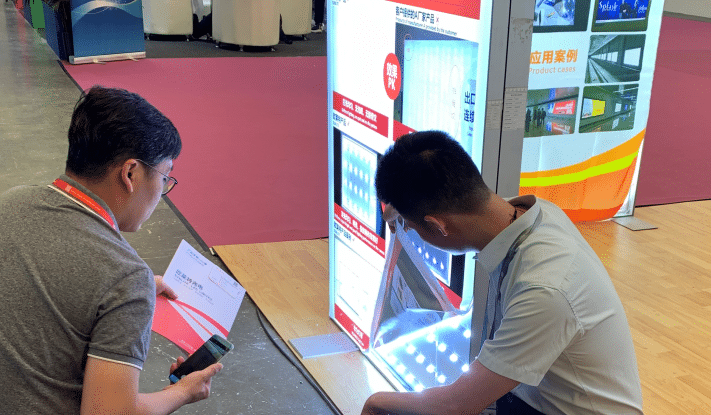
Tools and materials required
To achieve proper installation of LED light bars, you need the right tools and materials. Here’s a list to guide you:
LED light bars: Choose high-quality bars that fit your lightbox dimensions.
Power supply: Ensure it matches the voltage and wattage of your light bars.
Screwdrivers: Secure mounting brackets or screws.
Wire cutters: Trim excess wiring for a neat setup.
Pliers: Grip and bend wires during connections.
Measuring tape: Measure dimensions and spacing accurately.
Level: Align light bars perfectly.
Drill: Create holes for mounting brackets or screws.
Mounting brackets or adhesive strips: Securely attach light bars to the frame.
Wiring connectors: Join wires neatly.
Electrical tape: Insulate connections to prevent short circuits.
Step-by-step guide to install LED light bars
Preparing the lightbox
Start by cleaning the interior surface of your lightbox. Remove any old lighting components or debris. This ensures a smooth surface for easy installation and optimal light diffusion.
Positioning the LED light bars
Mark the placement of the light bars to ensure even spacing. Use a measuring tape and level to maintain alignment. Secure the bars using mounting brackets or adhesive strips, depending on your setup.
Connecting the power supply and wiring
Route the wiring neatly along the edges of the lightbox. Connect the wires to the power supply, ensuring proper polarity. Use wiring connectors for secure joins and electrical tape for insulation.
Testing and final adjustments
Power on the lightbox to test the functionality of the LED light bars. Check for shadows, flickering, or uneven lighting. Adjust the placement or beam angles as needed to achieve uniform brightness.
Tips for optimal installation
Avoiding shadows and dark spots
Position the light bars at equal intervals to eliminate dark spots. Overlap light beams slightly to ensure consistent illumination. Use diffusers or frosted panels to soften the light and create an even glow.
Ensuring proper ventilation for heat dissipation
Allow space around the light bars for airflow. Proper ventilation prevents overheating, which can reduce the lifespan of your LED light bar. Avoid packing the bars too tightly to maintain performance.
💡 Pro Tip: Plan your installation layout carefully to avoid common mistakes like loose connections or improper spacing. This ensures a professional finish and long-lasting performance.
LED light bars play a vital role in creating uniform illumination for lightbox signage. They enhance both the functionality and aesthetics of your display by eliminating shadows and ensuring consistent brightness. Choosing the right type, such as edge-lit for sleek designs or backlit for larger signs, optimizes performance. Proper installation and regular maintenance, like cleaning and inspecting for dust, ensure long-lasting durability and enhanced safety. Their energy efficiency and ease of use make them a superior choice for modern signage, whether for indoor or outdoor applications.
🌟 Tip: Use high-quality materials and incorporate diffusers to achieve a smooth, even glow while minimizing harsh shadows.
FAQ
What makes LED lights ideal for lightbox signage?
LED lights provide bright, uniform illumination while consuming less energy. Their compact size fits seamlessly into light box designs. They also last longer than traditional lighting, reducing maintenance needs. These features make them perfect for lightbox signage, especially in dark or low-visibility conditions.
How do you choose the right LED lights for your light box?
Select LED lights based on your light box size and purpose. For smaller designs, edge-lit LEDs work well. For larger displays, backlit LEDs ensure even brightness. Always check the beam angle and power requirements to match your lightbox signage needs.
Can LED lights work in low-visibility conditions?
Yes, LED lights excel in low-visibility conditions. They emit bright, consistent light that enhances visibility. This makes them ideal for lightbox signage used in dark or low-visibility conditions, ensuring your message remains clear and attention-grabbing.
How do you maintain LED lights in a light box?
Clean the light box interior regularly to remove dust. Check the wiring and connections for wear. Ensure proper ventilation to prevent overheating. These steps keep your LED lights functioning efficiently and extend their lifespan.
Are LED lights environmentally friendly?
Yes, LED lights are eco-friendly. They consume less energy, reducing your carbon footprint. They also generate minimal heat and contain no hazardous materials. Using LED lights in your lightbox signage supports sustainable practices while delivering excellent performance.
See Also
How To Install LED Light Bars For Signage
Understanding The Functionality Of Backlit LED Light Bars
Using Edgelit LED Bars For Effective Lightbox Illumination
